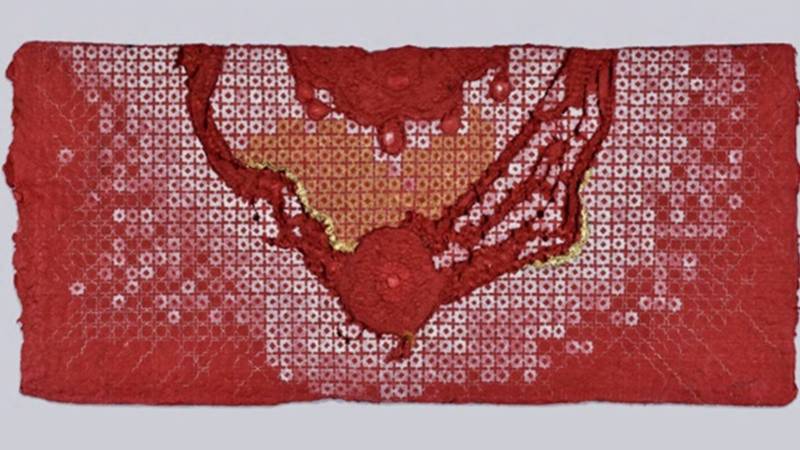
There are multiple forms of disappearances: forced, voluntary, strategic; individual, collective, political; physical, emotional, virtual, personal, etc. EH Gombrich in The Story of Art, has included a Greek relief, “Tombstone of Hegeso,” showing the image of a seated woman next to a young girl. The elderly person, perhaps the deceased, is holding a necklace and looking at it, longingly.
Both, the female who lived around 420 BC, and the piece of jewellery from Athens, have long disappeared. Yet what is still present is the link between the eyes and the artefact. There is another association, the memory of human contact. Earrings, necklaces, bracelets, bangles, nose pins, anklets, and pendants all touch the flesh of the person wearing these. That connection alters the human skin, as well as the object. Often one notices how the area covered by certain pieces of jewellery – if used for too long – is untanned; often heavy earrings enlarge the small holes over the years. Most women, from South Asia, Middle East and other parts of the world, get their ears and nose pierced to put in their traditional jewelleries.
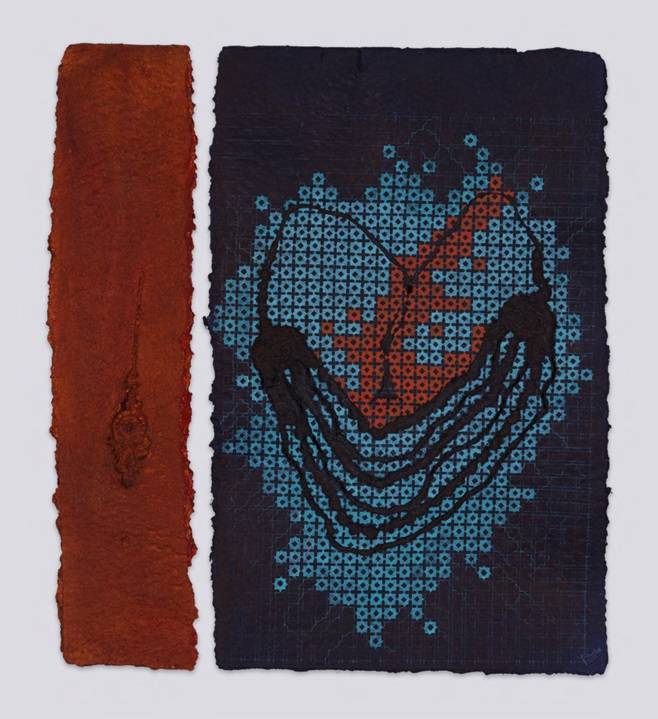
Be it an intimate piece or a product for outer adornment, jewellery remains an important part in a female’s body, possessions, recollections, desires and dreams. Minaa Haroon captures that connection in her recent body of work. Usually when referring to a collection of art pieces, the term ‘body of work’ is applied, but in Haroon’s case it is not just an easily available phrase, because in its essence, the work is about the body, its presence, and its disappearance.
The Spanish author Javier Marias, in one of his novels, observes that we leave part of ourselves in every space and every object we used – even if temporarily. Often imperceptible or invisible, but the residue of one’s body exists. When we leave a bed, the creases on the white linen, folds on the pillow covers, bends in the duvet, embody our nightly presence. A pair of shoes worn for years betrays the owner’s anatomy, character, posture, pace. A kitchen knife loses its initial shape after years of usage. Our bodies – and our psyches deposit a portion of ourselves on things we own. Much like our possessions invade/change our anatomies.
Be it an intimate piece or a product for outer adornment, jewellery remains an important part in a female’s body, possessions, recollections, desires and dreams. Minaa Haroon captures that connection in her recent body of work
At her solo exhibition “Terms of Adornment,” curated by Aasim Akhtar, and held from the 23rd May to the 4th of June 2024 at Khaas Contemporary, Islamabad, Minaa Haroon has displayed works which deal with the body in multiple ways. Her surfaces and mediums emanate a strong sense of body, since most of these art pieces are executed in “gouache and direct dye on cotton plant fibre, recycled paper and alum.” The pulpy appearance of her handmade paper, its thickness and substance invite a viewer’s gaze differently from the surface of a plain machine-made paper. A difference, similar to our interaction with a living being and our handling of a machine, tool, gadget. The former generates a warm experience, whereas the latter releases a cold and dry feeling.
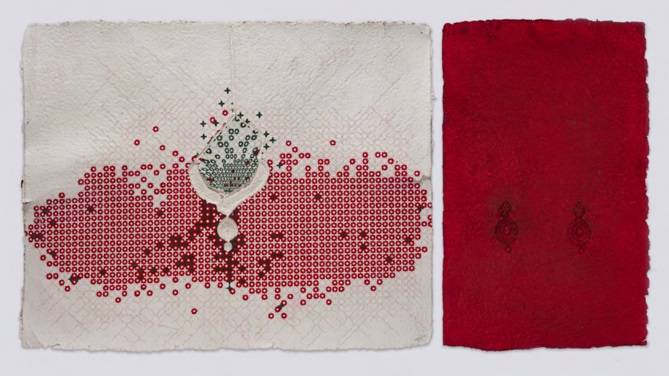
Haroon’s imagery, choice of colour and preference in picture making also allude to her intended theme. Each work on paper contains the impression of one or a few jewellery pieces, i.e., necklace, earrings, pendant, examples of South Asian artefacts usually associated with weddings. Haroon adds shapes of traditional patterns around her central motif/article, to communicate the rich heritage of image making, which for years was not even considered art, or worthy of a subject in artmaking.
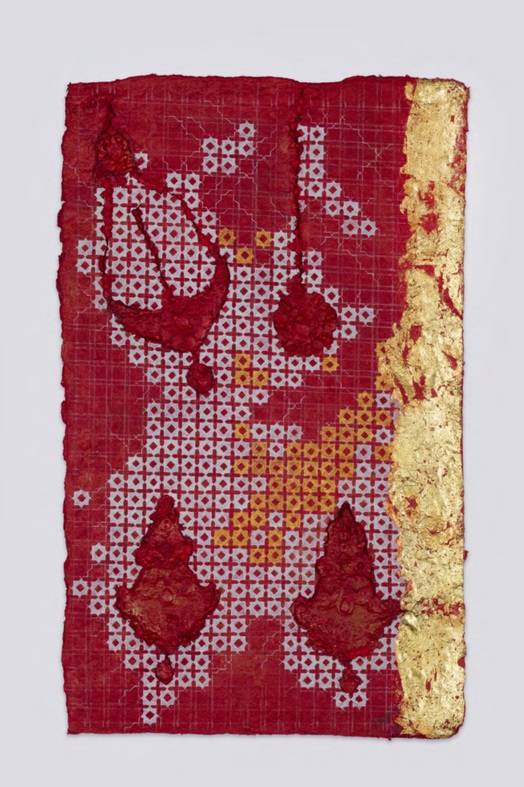
The relationship of her imagery to the institution of marriage is further evident in her careful and calculated selection of colour. A majority of these paintings have an extensive red hue, with occasional streaks of gold, and are titled “Hujla-e-Aroosi” (matrimonial chamber) and “Parsa” (chaste). The red is a predominant shade in Indo-Pak weddings; the colour of a bride’s dress, surrounded with garlands of red roses, henna on hands and feet, sindoor (only wedded women can put this powder between their hair partition), red bindis or tikas . For years the conventional marriages were an affair of red, with sweetmeat packed in red boxes, wedding invitation printed in red text – even Pakistani caterers used to provide chairs to marriage functions in red seats and backrests!
However there is another significance of red when it comes to marriages in orthodox societies. Blood stain on the day after, which in some communities is proudly displayed in the morning for the entire group of family members and guests. Thus the tint stays in the minds of many growing girls as a huge pressure/duty – eventually to be lost.
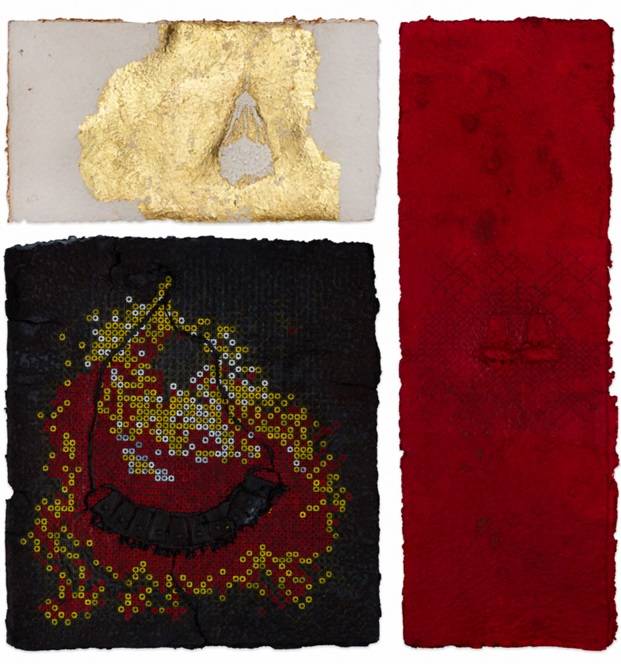
The sense of loss is perceived during other ceremonies and rituals of marriage. The bride leaves her home, parents, siblings, relatives, friends – and her surname in some cases after signing the marriage contract. Hence an atmosphere of funeral once the groom’s entourage departs with their prized possession/person. Wailing, crying, and tears are/were the last act of the marriage ceremony.
In Minaa Haroon’s work, you actually don’t find anything except loss, but that loss is so great, enticing, and engaging that it fills you enormously. The imagery and technique of rendering it relate to loss of another kind. A personal one. After her father’s death, the artist’s family found it difficult to retain the family property due to the greed and schemes of distant relatives, thus it had to part away with mother’s precious jewellery for young children’s upbringing and education. Minaa Haroon’s work is an impressive example in transforming a private and personal matter into a metaphor of multiple meanings. One can read it as a cultural loss of a society abandoning its distinct practices; or admire the glorious heritage of South Asian art; or contemplate on the absence of a divide between art and craft before it was introduced by colonialism in the Indian subcontinent.
Her meticulously fabricated work alludes to a significant aspect of our lives. What we possess, we hardly care for, but what is lost is missed, and fondly and repeatedly recalled. The irreversible loss makes its way more firmly in our minds, than what we daily encounter in our immediate surroundings.
It reminds one of a joke: towards the end of an amorous relationship, the girl asks the boy for a gold ring, so it could remind her of him. The boy, on the other hand, firmly declines, saying that whenever she would look at her finger without the ring, she would remember him – all the more, and intensely!

